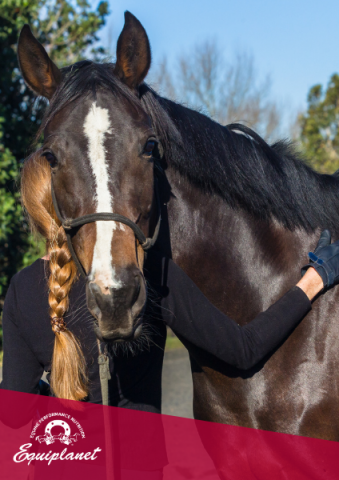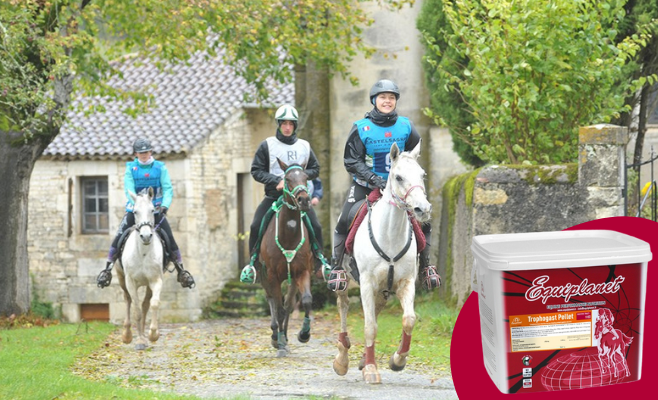
Old Horse: Nutritional Management
26 October 2020
Yearling Period: Balanced diet for best development in the first year of horse life
26 April 2021Resume Sports Activity: 3 Equiplanet Tips


The spring season is just around the corner and with the warm weather, competitions and shows are back in full swing after a period of lower intensity. It is useful to adapt the ration gradually to meet the needs of our horses. Here are some tips to improve performance:
1- Gives muscle elasticity to the horse for resuming sporting activity:
Muscle toning after a period of inactivity may be slow due to distanting training in time or of reduced duration or intensity. This leads to increase lactic acid production and consequent muscle damage. It is indispensable to protect the muscles from oxygen free radical damage and to support the metabolism of lactic acid, promoting its elimination.

A useful feed is Muscle racing New, complementary feed containing antioxidants and lactic acid buffers for muscle elasticity. This product in powder form contains Selenium and Vitamins with an antioxidant effect, Glycine, Betaine and Carnitine whose unique composition helps the horse to find condition and allows better recovery after training sessions. They are useful in protecting muscles from free radical damage, promoting muscle activity, counteracting the production of lactic acid and providing elasticity of movement.
2- Helps to respond the horse’s stress due to re-start of sporting activity:
One of the common characteristics that has always accompanied the horse, whatever its discipline, is living with numerous sources of stress. Stabling, separation from the herd, feed’s changes and transport are all variations that cause tension in the horse. Similarly, the recommencement of competitions is also a stressful time for the horse, whose discomfort affects its stomach, the target organ of stress. Training causes alterations in the horse’s appetite and prolongs periods of fasting with an increase in gastric acidity. In addition, physical activity and fatigue decrease the circulation of the gastric mucosa and the body’s defences. To support the stomach mucosa, it is important to feed complementary feeds that maintain its normal physiological integrity.

Trophogast pellets thanks to it’s form in pellet, is easy to add it to the usual feed and need to be used for at least 20-30 days, to support the horse when it re-start competition activity in combination with a correct intake of concentrates and good quality hay, possibly ad libitum.

In order to make the change in the horse’s pace in spring as smooth as possible, complementary feeds that affect the emotional balance based on the following are useful Tryptophan and Magnesium, such as Tranquillity, to be used especially in individuals that are more nevril.
3- Helps the enteric function of the horse when resuming sporting activity:
During rest periods, it is usual to decrease the amount of concentrates fed to the horse, with the resumption of competitions, the amount of feed is increased because the caloric consumption due to exercise increases. Under normal conditions, stabled sport horses are only fed two or three times during the day, with often-high amounts of concentrates and negligible hay consumption. Starch is undoubtedly the most difficult nutrient fraction for the horse to digest as it is by nature a strict herbivore and the use of concentrates is necessary to provide energy available for work. Consequently the horse has no feed available for long periods of time and during competitions fasting is often prolonged. Probiotics can be included in the daily ration to counteract and minimise the negative effects of changes in the intestinal population.

Probiotics are live microorganisms that enhance the healthy bacterial population and improve fibre digestion. These include yeast strains such as Saccharomyces cerevisiae
Several studies suggest that by supplementing the ration with live yeast, negative changes to the intestinal ecosystem are limited, reducing the pH drop after concentrate meals. In addition, the digestibility of the fibre is also increased, allowing the horse to maximise the nutritional value of the ration.

A horse that is preparing for a change in diet, with an increase in exercise intensity should use complementary feeds such as Equigest based on Saccaromyces cerevisiae for at least 20 days or else. If the decision is made not only to change the amount of concentrates but also to introduce another feed, it is best to supplement with Enterovet, which in addition to probiotics also contains prebiotics such as inulin, which acts on the bacterial ecosystem by reducing the incidence of harmful bacteria, and Yucca Schidigera which improves caecal fermentation.
Per rimanere aggiornato sui nostri contenuti seguici su Instagram
Bibliography
- Problems In Equine Nutrition. JD. Pagan, 2004
- Effect of a preparation of Saccharomyces cerevisiae on microbial profiles and fermentation patterns in the large intestine of horses fed a high fiber or a high starch diet. B. Medina, 2002
- A review of equine muscle disorders. M. Aleman, 2008
- Maximal Lactate Concentrations In Horses After Exercise Of Different Duration And Intensity. A. Lindner, 1992
- Factors influencing equine gut microbiota: current knowledge. Anna Garber, 2020
- The Bacterial Community of the Horse Gastrointestinal Tract and Its Relation to Fermentative Acidosis, Laminitis, Colic, and Stomach Ulcers. Rafat A.M. Al Jassim, 2009
- The equine gastro-intestinal tract: An overview of the microbiota, disease and treatment. L. M. T. Dicks, 2014

